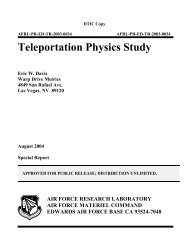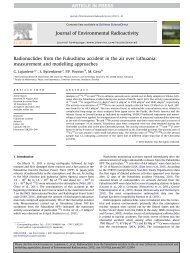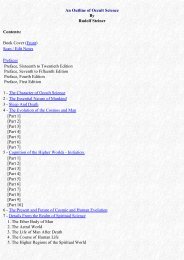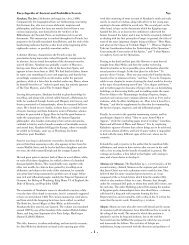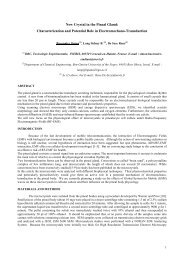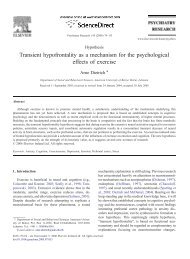Psychology of Terrorism - National Criminal Justice Reference Service
Psychology of Terrorism - National Criminal Justice Reference Service
Psychology of Terrorism - National Criminal Justice Reference Service
Create successful ePaper yourself
Turn your PDF publications into a flip-book with our unique Google optimized e-Paper software.
ather then from their own volition. Because they are not the actual agents <strong>of</strong> their actions, they arespared self-prohibiting reactions.-The deterrent power <strong>of</strong> self-sanctions is weakened when responsibility for culpable behavior isdiffused, thereby obscuring the link between conduct and its consequences. Responsibility can bediffused in several ways, for example, by the division <strong>of</strong> labor.-Collective actions is still another diffusion expedient for weakening self restraints.-Additional ways <strong>of</strong> weakening self-deterring reactions operate through disregard for ormisrepresentation <strong>of</strong> the consequences <strong>of</strong> action. When people choose to pursue activities that areharmful to others for reasons <strong>of</strong> personal gain or social inducements, they avoid facing or minimizethe harm they cause.-The final set <strong>of</strong> disengagement practices operates on the targets <strong>of</strong> violence acts. The strength <strong>of</strong>self-censuring reactions to injurious conduct depends partly on how the perpetrator views the peopletoward whom the harmful is directed. To perceive another person as human enhances empathetic orvicarious reactions through perceived similarity. The joys and suffering <strong>of</strong> similar persons are morevicariously arousing than are the joys and suffering <strong>of</strong> strangers or <strong>of</strong> persons who have beendivested <strong>of</strong> human qualities.-Self-sanctions against cruel conduct can be disengaged or blunted by divesting people <strong>of</strong> humanqualities.-Imputing blame to one’s antagonist is still another expedient that can serve self-exonerativepurposes; one’s own violent conduct can then be viewed as compelled by forcible provocation.-The path to terrorism can be shaped by fortuitous factors as well as by the conjoint influence <strong>of</strong>personal predilections and social inducements.13. Beck, A. T. (2002). Prisoners <strong>of</strong> Hate. Behavior Research and Therapy, 40(3), 209-216.Call Number: Key Quote Summary: Authors Abstract:The terrorist attacks in New York andWashington, D.C. on September 11, 2001 as well as domestic terrorism in the United States andelsewhere in the world has prompted an analysis <strong>of</strong> the psychology <strong>of</strong> the terrorist. The perpetratorspr<strong>of</strong>ound sense <strong>of</strong> being wronged their values undermined by foreign powers or a corrupt domesticpower structure has cried out for revolution and revenge. The fanatic ideology <strong>of</strong> the perpetrators hasprovided the matrix for a progressively more malevolent representation <strong>of</strong> the oppressors: the image<strong>of</strong> the enemy. Retribution against the Enemy in the form <strong>of</strong> mass murder <strong>of</strong> anonymous civiliansbecomes an imperative. The counterpart <strong>of</strong> the image <strong>of</strong> the enemy is the idealized collective selfimage<strong>of</strong> members <strong>of</strong> the movement, faction, or cult. The group narcissism <strong>of</strong> the white supremacistsin the United States, the Aum Shinrikyo in Japan, and the Islamic extremists enhance their collectiveself-image as pure, righteous, and united. While the foot soldiers, as in any war, gain glory throughmartyrdom, the instigators and leaders have their own personal narcissistic goals (power andprestige) and plan. For the extremist Islamists the ultimate goal has been overthrow <strong>of</strong> the moderateIslamic governments; for the domestic terrorists, destabilization <strong>of</strong> the national government andreinstitution <strong>of</strong> the traditional values.-What then is the psychology <strong>of</strong> the terrorist? It is crucial to understand that their ideologyconcentrates their thinking and controls their actions.-Driving violent acts <strong>of</strong> this type is the perpetrators’ view <strong>of</strong> the victim: the image <strong>of</strong> the Enemy.-Islamic radicals who become obsessed with these polarized images are prime candidates forrecruitment for assignments <strong>of</strong> assault on the enemy.-They have demonized their antagonists and dehumanized its people.-The thinking <strong>of</strong> the terrorist evidently shows the same kind <strong>of</strong> cognitive distortions observed inothers who engage in violent acts, either solely as individuals or as members <strong>of</strong> a group. Theseinclude overgeneralization that is, the supposed sins <strong>of</strong> the Enemy may spread to encompass theentire population. Also, they show dichotomous thinking a people are either totally good or totallybad. Finally, they demonstrate tunnel vision once they are engaged in their holy mission (e.g., jihad),their thinking, and consequently their actions, focuses exclusively on the destruction <strong>of</strong> the target.-The perspective <strong>of</strong> the psychology <strong>of</strong> the terrorist needs to be extended to the polarized thinking <strong>of</strong>the militant fundamentalist groups that are the breeding grounds <strong>of</strong> the terrorists.-The cognitive approach to “hot” violence (that is associated with anger) is based on two premises.First, people are people whether they are operating individually or in groups. Secondly, the violentlyhostile person has strong negative biases toward the victim: the greater the degree <strong>of</strong> bias and degree



